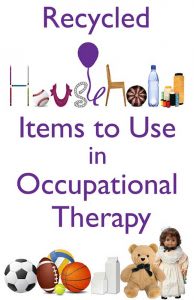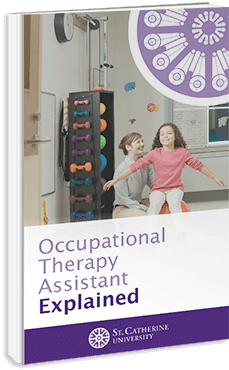Recycled Household Items to Use in Occupational Therapy
Each blog post is dated and contains accurate information as of that date. Certain information may have changed since the blog post publication date. If you would like to confirm the current accuracy of blog information, please visit our Online OTA program overview page or contact us at (877) 223-2677.

Occupational therapy is one of those rare fields where you’re able to work in a rewarding career geared towards improving the lives of others while simultaneously having a lot of fun. Like any other medical career, becoming an OTA requires a lot of dedication, both in an out of school, and it comes with its fair share of stress. However, occupational therapy allows for a lot of creativity, whether you’re working in pediatric therapy, geriatric therapy, physical rehabilitation or mental health specialization.
When you’re working on improving motor skills, sensory development or self-help skills, you have plenty of different options for patient activities. Instead of worrying about buying pricey gadgets and toys for your patients, utilize what both you and your patients already have around the house.
Pediatric Therapy
Children who require occupational therapy are typically trying to overcome two challenges: motor-skills development and sensory development.
Gross Motor Skills
Kids struggling with gross motor skills development struggle with major muscle groups, so their balance coordination and endurance are all thrown off. Creating obstacle courses are a great way to help improve a patient’s gross motor skills. Use masking tape or duct tape to create a course. Pillows, cushions and blankets make great obstacles for children to crawl under, jump over and climb through. Balls of different sizes and weights, for example baseballs, softballs, footballs and volleyballs, can be useful for improving balance and coordination. You can try a simple game of catch or kickball, or try a bowling game with empty soda bottles or milk cartons. Red yarn can help make a fun “laser” obstacle course for children to crawl through as well.
Fine Motor Skills
Children who have trouble with hand dexterity or strength may be struggling with their fine motor skills. However, children can have plenty of fun improving these skills. If you have spare ribbon or yarn, have the children work on threading the piece of fabric through buttons or beads. You can also create your own version of Ker Plunk. If you have an old clear plastic shampoo or soap bottle, cut off both ends and drill some holes big enough for chopsticks to fit through. This clever crafter sewed some toddler clothes onto a stuffed animal so children can practice zipping up sweaters, buttoning up jeans, closing a belt and tying shoes.
Sensory Processing
Some patients have problems with sensitivity, whether its touch, sound, taste, smell or sight. There are plenty of DIY activities that can help with touch. If you have balloons, fill them with varying textures and tie off the ends. You can try play dough, flour, rice, beans and water. A muffin tin filled with shaving cream and food coloring is a great way for children to practice finger painting. Water beads can be placed in a small container and filled with various toys, such as magnetic letters, cars or small dolls, for children to use as sensory tubs.
Pinterest is also full of various other ideas for children’s activities.
Geriatric Care
Geriatric occupational therapy patient care is different from pediatric care. Together, seniors and OTAs work towards ensuring independence, creating tasks to make taking care of themselves easier. Those who require geriatric occupational therapy may need it because they suffer from memory loss, physical problems due to arthritis or are simply adapting to the many problems that arise as they age.
Some simple products could make life for geriatric patients much simpler. One writer, who suffers from arthritis, learned to adapt common kitchen items so she could continue to cook healthy meals at home. Some patients may not be able to hold small utensils, such as combs, toothbrushes or cutlery. Simple sponge curlers can be fitted around the handles, offering a larger and softer grip. Medicine can be especially problematic. Ensure your patients have easy-open caps on their prescription bottles. Many child-safety lids can be flipped and screwed on upside-down. Be sure children can’t access these bottles.
Many patients require exercises or stretches to help with pain and to avoid losing strength. Create your own exercise bands with an old pair of suspenders or some spare bungee cord.
Some patients may need to work on their fine motor and gross motor skills, so the above pediatric activities could be used for geriatric patients as well.
Psychiatric Patients
Patients who may need psychiatric help are not confined to hospital settings. Many are able to care for themselves with the help of a few adapted treatments. Occupational therapy assistants can help patients improve life skills, cognitive rehabilitation, life balance and social and interpersonal skills.
Psychiatric patients can be all ages, so you may find yourself working with children or adults. Some patients respond very well to arts and crafts, so take advantage of all of the construction paper, markers, pencils, ribbons, fabric and pipe cleaners floating around your house. Create a calendar for patients who require a lot of organization to live independently.
As an OTA, you’ll have access to the best tools and resources to improve your patients’ lives. However, part of the fun of being an occupational therapy assistant is being creative with what you and your patients already have around you.
If you’re interested in working as an occupational therapy assistant, contact us today about enrolling in St. Catherine University’s online OTA program.


